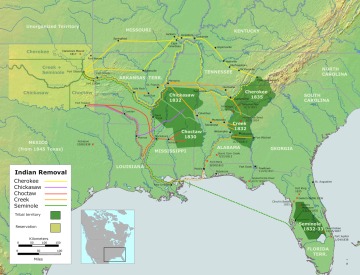1817: U.S. frontier advances, pushing Native peoples westward
All along its western border, the U.S. presses for more land to accommodate the expanding nation. To avoid ongoing conflicts with growing numbers of settlers, Native peoples from the Old Northwest (Ohio, Michigan, Indiana, Illinois, Wisconsin, Minnesota) and Old Southwest (Alabama, Louisiana, Tennessee) move farther west. The U.S. bribes some of the Cherokee to exchange their homeland throughout the southeastern U.S. for land on the Arkansas River, and 2,000 Cherokees move there.
Throughout the nation’s history, the U.S. has used the term Indian Territory to talk about land that is still under the control of Native peoples. “Indian Territory” moves farther west as the U.S. frontier pushes westward.
- Theme
- Federal-Tribal Relations, Land and Water
- Region
- Northeast, Southeast
Map showing the Cherokee Trail of Tears and other forced relocation marches.
During the 1830s the U.S. government forced tens of thousands of Native Americans, including many members of the Cherokee, Muscogee Creek, Seminole, and Choctaw nations from their homelands to Indian Territory (present day Oklahoma). The phrase “Trail of Tears” originated from a description of the removal of the Choctaw Nation in 1831.
